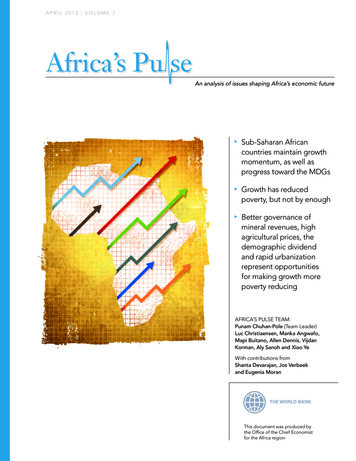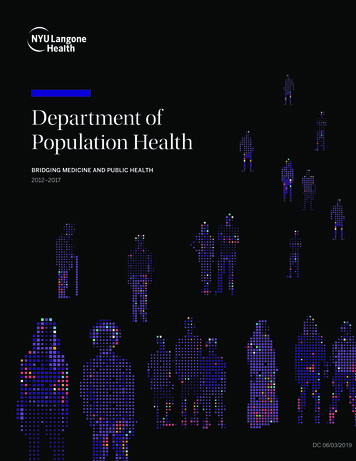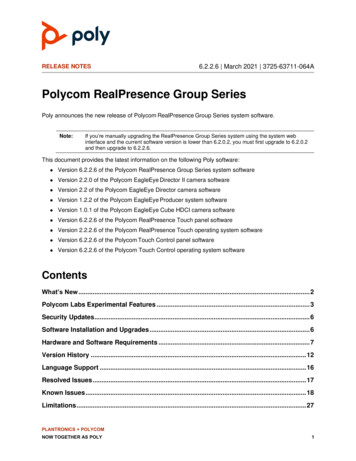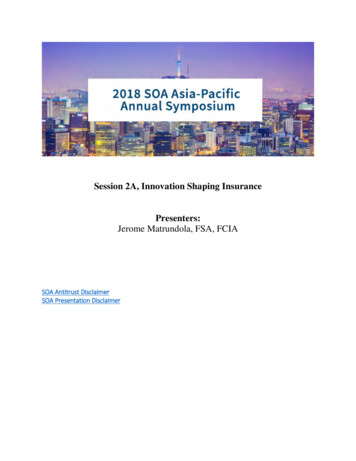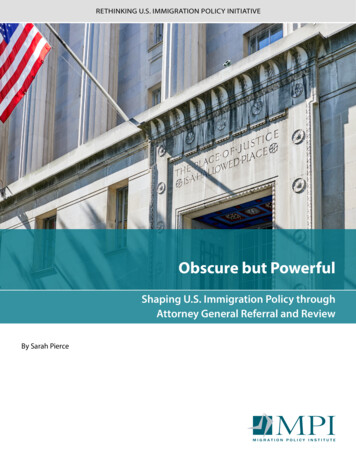
Transcription
RETHINKING U.S. IMMIGRATION POLICY INITIATIVEObscure but PowerfulShaping U.S. Immigration Policy throughAttorney General Referral and ReviewBy Sarah Pierce
U.S. IMMIGRATION POLICY PROGRAMObscure but PowerfulShaping U.S. Immigration Policy throughAttorney General Referral and ReviewBy Sarah PierceMigration Policy InstituteJanuary 2021
ContentsExecutive Summary. 11Introduction. 22History of the Attorney General’s Referral and Review Power . 334A.The Homeland Security Act and Its Effects.6B.Referral and Review as an Administrative Tool.9The Trump Administration’s Use of Self-Referral. 12A.Restricting Access to Asylum. 13B.Eliminating Immigration Judge Discretion. 17The Future of Self-Referral. 19A.B.5Beyond the Trump Administration. 20Establishing Procedural Requirements to Increase Transparency and SupportHigh-Quality Decisions. 21Conclusion. 24About the Author. 26Acknowledgments. 27
SHAPING U.S. IMMIGRATION POLICY THROUGH ATTORNEY GENERAL REFERRAL AND REVIEWExecutive SummaryIn making wide-reaching changes to the U.S. immigration system, the Trump administration employed arange of executive action tools. One of them is a little known but powerful authority of the attorney generalto alter or reinterpret the application of immigration laws. Through a series of consequential decisions, theTrump administration’s attorneys general elevated the reach and public profile of this obscure bureaucratictool, raising questions about its historic roots, appropriate use, and future relevance.Formally called the “referral and review power,”The Trump administration’s attorneysthe authority allows the attorney generalto review and overrule decisions made bygeneral elevated the reach and publicthe Board of Immigration Appeals (BIA), theprofile of this obscure bureaucratic tool,immigration appellate body housed within theU.S. Department of Justice. Trump administration raising questions about its historic roots,appropriate use, and future relevance.attorneys general referred more cases tothemselves for review than under any prioradministration, Democratic or Republican. These decisions stretched beyond the norms and traditionalboundaries of the exercise of this power, making substantive changes to legal regimes—such as the U.S.asylum system—as well as to court procedures, including how immigration judges manage their individualdockets.This increase in the frequency of use and impact of the attorney general’s power has exacerbated concernsthat predate the Trump administration. Allowing the attorney general—the country’s chief law enforcementofficer—to intercede in individual immigration cases has raised questions about the true independenceof the immigration adjudication system. In addition, attorneys general have issued these decisions withminimal procedural safeguards or transparency; regulations require only that the decision be issued inwriting to the affected parties. Attorneys general have frequently issued decisions without input fromthe parties in the case or other relevant stakeholders, and many times, the affected parties have not evenbeen aware that the attorney general has taken up their case until after the decision is issued. The lackof transparency and, at times, failure to fully brief the legal issues also have negative implications for thelegal and policy soundness of attorney general decisions and their acceptance by the broader populationsultimately affected by those decisions.Beyond questions of procedural consistency and transparency, the fact that this authority has remainedwithin the Justice Department is itself problematic. Before the creation of the U.S. Department of HomelandSecurity (DHS) under the Homeland Security Act of 2002, most immigration functions were under thejurisdiction of the Justice Department, headed by the attorney general. The 2002 law moved the bulk ofimmigration policy-making and operations to DHS. Thus, attorneys general no longer hold the expertisethat is derived from overseeing immigration operations nor are they tasked with immigration policymaking, yet their decisions can bind DHS, even over that agency’s protests. Since 2003, attorneys generalhave used this power to make significant policy changes, ranging from abandoning well-establishedcriteria for granting asylum and changing the immigration consequences of certain criminal convictions, toMIGRATION POLICY INSTITUTE 1
SHAPING U.S. IMMIGRATION POLICY THROUGH ATTORNEY GENERAL REFERRAL AND REVIEWdissolving the constitutional right of foreignnationals in removal proceedings to effectiveassistance of counsel.BOX 1About the Rethinking U.S. Immigration Policy ProjectThis report is part of a multiyear Migration Policy Institute(MPI) project, Rethinking U.S. Immigration Policy. At aThe Trump administration’s aggressive use oftime when U.S. immigration realities are changing rapidly,the referral and review power invited strongerthis initiative aims to generate a big-picture, evidencescrutiny than ever before. Some of the concernsdriven vision of the role immigration can and should playraised in this and prior administrations couldin America’s future. It will provide research, analysis, andbe addressed by establishing more formalpolicy ideas and proposals—both administrative andprocedures and increasing the transparencylegislative—that reflect these new realities and needs forimmigration to better align with U.S. national interests.surrounding the power’s use. Such proceduralsafeguards would increase the quality andThe research, analyses, and convenings conducted foracceptability of decisions, but tackling theMPI’s Rethinking initiative address critical immigrationdeeper issues associated with this authority’sissues, which include economic competitiveness, nationallocation within an agency that is no longersecurity, and changing demographic trends, as well asin the lead on immigration will require aissues of immigration enforcement and administering thecritical rethinking of the effective use of thisnation’s immigration system.power along with its appropriate placementTo learn more about the project and read the otherwithin the immigration bureaucracy. Referralstudies generated by the Rethinking U.S. Immigrationand review provides a ready tool for any newPolicy initiative, see bit.ly/RethinkingImmigration.administration to undo prior policy measuresand nimbly and efficiently introduce differentideas for improving the performance of the U.S. immigration system, but it must be trusted to produce highquality decisions that advance a coherent and consistent immigration policy.1IntroductionUsing executive authority, the administration of President Donald J. Trump made more significant changesto the U.S. immigration system than any other administration in modern memory. In the face of inactionby Congress—apart from restricting some of the president’s hefty spending asks—the administrationtapped into the wide range of options at its disposal to influence immigration policy, including invokingunderutilized laws, issuing regulations and executive orders, and taking up other bureaucratic tools. Amongthese tools is an obscure but powerful legal authority—the attorney general’s ability to self-refer and reviewimmigration court decisions.This tool, at times referred to as “certification,” is an extension of the attorney general’s authority overdecisions made by the immigration appeals court, the Board of Immigration Appeals (BIA), which is housedin the U.S. Department of Justice. It allows attorneys general to refer any BIA decisions to themselves forreview. The U.S. Department of Homeland Security (DHS) and the BIA may also refer decisions for theattorney general to review, as could DHS’s predecessor agency, the Immigration and Naturalization Service(INS).MIGRATION POLICY INSTITUTE 2
SHAPING U.S. IMMIGRATION POLICY THROUGH ATTORNEY GENERAL REFERRAL AND REVIEWHistorically, the referral and review power allowed attorneys general to efficiently exercise policy controland knit adjudications, rulemaking, and other bureaucratic decisions into one coherent immigration policyframework, as well as to solve disagreements between the BIA and INS. At the same time, there have alwaysbeen questions about whether referral and review violates the due process rights of the immediate partiesin a case, as well as about the soundness and broad acceptance of the decisions, given the extraordinarypower it concentrates in the hands of the nation’s chief law enforcement officer. In essence, it gives theattorney general the final say on administrative decision-making in immigration law.Referral and review significantly increased in scopeand importance with the enactment of the HomelandSecurity Act of 2002 (HSA), which moved the majority ofimmigration functions out of the Justice Departmentand into the newly formed DHS. As broader authorityover immigration matters was shifted out of the JusticeDepartment, attorneys general increasingly used theirpower to influence immigration policy. Since the March 1, 2003, implementation of HSA, with only oneexception, every case referred to the attorney general has been self-referred—28 of 29 cases as of January2021.As broader authority overimmigration matters was shifted outof the Justice Department, attorneysgeneral increasingly used their powerto influence immigration policy.Under Trump, attorneys general exercised this authority even more than in prior administrations,implementing significant changes that include paring down the authority of immigration judges to exercisediscretion and manage their dockets, upending decades of established precedent to change asylum law,and making it more difficult for immigrants with criminal records to remain in the country.This report details the evolution and impact of referral and review. It begins by summarizing the history ofthis legal tool, the Trump administration’s use of it to accomplish specific policy objectives, and the possiblefuture uses of the power, including the Trump administration’s proposed expansion of it and how a newadministration could use it to improve the immigration system. The report concludes by recommendingnew procedures and increased transparency to boost the integrity of review decisions as well as to improvethe use of this power and its placement within the immigration bureaucracy.2History of the Attorney General’s Referral and ReviewPowerThe referral and review power is an extension of the attorney general’s historic authority over theimmigration system.1 When the Justice Department gained jurisdiction over the INS in 1940, the attorney1After decades of use, Congress finally recognized the review power in the Homeland Security Act of 2002: “The attorney generalshall review such administrative determinations in immigration proceedings.” See Homeland Security Act of 2002 (HSA), PublicLaw 107–296, U.S. Statutes at Large 116 (2002): 2135.MIGRATION POLICY INSTITUTE 3
SHAPING U.S. IMMIGRATION POLICY THROUGH ATTORNEY GENERAL REFERRAL AND REVIEWgeneral, via regulations, established the immigration appellate court—the BIA—giving himself and hissuccessors power over its decisions.2Between 1940 and 2003, referral and review of BIA decisions was a small but powerful part of the broadlegal and administrative portfolio of attorneys general in overseeing the immigration system. Today, evenafter the 2003 creation of DHS and the transfer of most immigration functions into this new department,the BIA remains in the Justice Department, where it continues to serve as an instrument for the exercise ofthe attorney general’s power over immigration. By regulation, the BIA has authority to exercise independentjudgment and issue its own decisions.3 But those decisions are subject to final review by the attorneygeneral, through the referral and review power.The procedures for how cases are referred to the attorney general and by whom have changed over theyears. At first, only specific types of cases could be referred. A 1940 Justice Department regulation—the same one that formally created the BIA—specified that a case could be referred if (1) it involveda particularly difficult legal question, (2) the BIA had ordered the suspension of a foreign national’sdeportation, or (3) the attorney general directed that the case be referred.4In 1947, the regulation was amended to eliminate the substantive criteria for referral (points 1 and 2 above)and simply designated who could refer a case. The regulation allowed the BIA and attorney general to refercases at any time but specified that the commissioner of the INS could only refer a case if the BIA agreed.5 In1952, the Justice Department removed this impediment, giving INS the full right to appeal BIA decisions toits highest administrative arbiter.6As immigration law has evolved, so has the use ofthe referral and review power, both in frequencyAs immigration law has evolved, so hasand justification. Initially, such decisions camethe use of the referral and review power,down with great frequency. Between 1942 andboth in frequency and justification.1952, attorneys general reviewed approximately 37cases per year.7 These decisions were often issuedwithout independent legal reasoning, stating as little as: “The foregoing decision and order of the Boardwere certified to and approved by the Attorney General.”82345678When the first quasi-immigration court was created in 1921—an advisory committee known as the Board of Review—it wasdesigned to assist the two government officials tasked at that time with immigration functions, the commissioner-general ofimmigration and the secretary of labor, and to provide a forum for oral argument. In 1940, the immigration functions weretransferred from the Department of Labor to the Department of Justice, and the Board of Immigration Appeals (BIA) was formallycreated by regulation of the attorney general, and it was made responsible directly to the attorney general. See Maurice A.Roberts, “The Board of Immigration Appeals: A Critical Appraisal,” San Diego Law Review 15, no. 29 (1977): 33–34.8 Code of Federal Regulations § 1003.1(d)(1)(ii). See also Tefel v. Reno, 972 Federal Supplement 608, 613 n.1 (U.S. District Court forthe Southern District of Florida, 1997).8 Code of Federal Regulations § 90.12 (1940).Justice Department, Immigration and Naturalization Service (INS), “Appeals from Orders Issued by Commissioner of Immigrationand Naturalization; Miscellaneous Amendments to Chapter,” Federal Register 12, no. 140 (July 14, 1947): 4781, 4782 (to be codifiedat 8 Code of Federal Regulation § 90.12).INS, “Immigration and Nationality Regulations,” Federal Register 17, no. 247 (Dec. 19, 1952): 11,469, 11,475 (to be codified at 8 Codeof Federal Regulations § 6.1 (h)(1)(iii)).Harry N. Rosenfield, “Necessary Administrative Reforms in the Immigration and Nationality Act of 1952,” Fordham Law Review 27,no. 2 (1958): 145, 158.Rosenfield, “Necessary Administrative Reforms,” 157. See, for example, In Matter of B---, 1 I&N Dec. 204 (BIA, August 5, 1942).MIGRATION POLICY INSTITUTE 4
SHAPING U.S. IMMIGRATION POLICY THROUGH ATTORNEY GENERAL REFERRAL AND REVIEWRather than set binding legal precedent, the intent was solely to adjudicate the merits of the case quicklybefore the Justice Department. Most of the referrals during this time came from the BIA, with those from INStrailing far behind, in part because the condition requiring BIA agreement on cases INS wished to refer hadnot yet been removed.As immigration jurisprudence developed further, the number of referred cases declined and the decisionsbecame more considered and consequential. Between 1953 and 1956, the pace slowed to about eight casesper year.9 And in 1955, the summary disposition of cases before the attorney general generally ended.10Decisions instead tended to be independently reasoned and articulated. For example, in 1955, in Matter ofR-R-, the attorney general reversed a BIA decision that held that a foreign national who had committed acrime could not be denied admission to the country if the crime at issue occurred before the enactment ofthe law that first made it a grounds for exclusion (the Immigration and Nationality Act of 1952).11 In reversingthe BIA decision, Attorney General Herbert Brownell, Jr., looked to the Senate Judiciary Committee report todeduce that Congress intended the law to also apply to crimes committed prior to enactment, making theforeign national excludable.For several decades after Brownell’s tenure, the number of referred decisions dropped to three or fourper year, or even less, and the reviews increasingly focused on cases whose resolution would havelasting importance beyond the individual case.12 In 1961, for example, in Matter of S- and B-C- AttorneyGeneral Robert Kennedy self-referred two cases in order to resolve an open legal quandary on fraudulentimmigration applications. The cases raised the question of when misrepresentations on applications forimmigration benefits are “material”—that is, when they are serious enough to merit denying applicantsadmission to the country or deporting them from it.13 Recognizing that prior related decisions on materialmisrepresentations made by the executive branch and the courts “have not been wholly clear or consistent,”Kennedy self-referred the cases to re-examine the issue.14 In the opinion, Kennedy articulated a three-steptest that is still used today, as illustrated by its inclusion in the U.S. Citizenship and Immigration Services(USCIS) policy manual (see Table 1).91011121314Alberto R. Gonzales and Patrick Glen, “Advancing Executive Branch Immigration Policy through the Attorney General’s ReviewAuthority,” Iowa Law Review 101, no. 3 (2016): 841–921, 857.Gonzales and Glen, “Advancing Executive Branch Immigration Policy,” 858–59. There was one post-1955 summary disposition, byAttorney General Nicholas Katzenbach in 1966.In the Matter of R—R—, 6 I&N Dec. 55 (BIA, July 29, 1955).Attorney General William Rogers issued only ten decisions between 1958 and 1961. Attorney General Robert Kennedy issued 11decisions during his tenure between 1961 and 1964. In the latter part of the Lyndon B. Johnson administration, ending in 1969,attorneys general issued four more decisions. See Gonzales and Glen, “Advancing Executive Branch Immigration Policy,” 857–58.One of the foreign nationals involved had failed repeatedly to disclose his past membership in the Communist Party on hisvisa applications. Upon admitting his misstatements, he explained that the membership was involuntary. Because involuntarymembership in the Communist Party is not grounds for exclusion, the INS decided the misrepresentation was not material andpermitted the foreign national’s admission. See Matter of S- and B-C-, 9 I&N Dec. 436 (Attorney General, October 2, 1961).Matter of S- and B-C-, 444.MIGRATION POLICY INSTITUTE 5
SHAPING U.S. IMMIGRATION POLICY THROUGH ATTORNEY GENERAL REFERRAL AND REVIEWTABLE 1USCIS Policy Manual Guidelines for Determining Whether Misrepresentation on an Application forImmigration Benefits Is MaterialStepIf Yes, then If No, then Step 1: Consider whether the evidence in the record supportsa finding that the applicant is (or was) inadmissible on the truefacts.Misrepresentationis materialProceed to Step 2Step 2: Consider whether misrepresentation tended to shut offa line of inquiry, which was relevant to the applicant’s eligibility.Proceed to Step 3Misrepresentationis NOT materialMisrepresentationStep 3: If a relevant line of inquiry had been cut off, askwhether that inquiry might have resulted in a determination of is materialineligibility. (The applicant has the burden to show that it wouldnot have resulted in ineligibility.)Misrepresentationis NOT materialSource: U.S. Citizenship and Immigration Services (USCIS), “Policy Manual, Chapter 3 – Adjudicating Inadmissibility,” accessed December29, 2020.From the late 1960s through the 1990s, the rate of referral and review remained low. Attorneys generalrarely employed this power throughout the presidencies of Richard Nixon (two cases referred to theattorney general), Gerald Ford (two), Jimmy Carter (one), Ronald Reagan (three), and George H.W. Bush(two), with an increase under Bill Clinton (eleven), as shown in Figure 1 below. Almost all of these cases werereferred by the INS Commissioner appealing BIA decisions.During this period, several attorneys general were quite active on immigration policy-making, but largelythrough other means.15 With INS still housed in the Justice Department, referral and review was only a smallpart of their broad legal and administrative portfolio in overseeing the immigration system. Attorneysgeneral had many ways to establish and participate in immigration policy-making, including setting policyand priorities for immigration enforcement, promulgating regulations on immigration benefits, or directingstrategy at the U.S. border.A.The Homeland Security Act and Its EffectsWith the passage of the HSA in 2002, Congress left the immigration court system in the Justice Departmentand, for the first time, recognized it in statute as the Executive Office for Immigration Review (EOIR). But allother direct powers over immigration policy and operations were reassigned to DHS. With more limitedmeans of influencing immigration policy, this marked the start of a fundamental shift in the use of thereferral and review power by attorneys general. Since then, it has significantly increased in importance.Whereas attorneys general historically used this power primarily as a tool for resolving intradepartmentaldisputes, since the HSA’s passage they have increasingly and nearly exclusively used the power to influenceimmigration policy broadly.15 For example, former Attorney General Benjamin Civiletti (1979–81) and Attorney General William Barr—during his first stint asattorney general under President George H. W. Bush (1991–93)—never reviewed an immigration case, even though they werequite active on immigration.MIGRATION POLICY INSTITUTE 6
SHAPING U.S. IMMIGRATION POLICY THROUGH ATTORNEY GENERAL REFERRAL AND REVIEWThe clearest evidence of this shift has been a change in the source of referred cases. With only oneexception, since the March 1, 2003, implementation of the HSA, every case that has been referred to theattorney general for review has been self-referred. Numbering 29 cases as of January 2021, 28 have beenself-referred.FIGURE 1Cases Referred to the Attorney General by Administration and Referring Entity, 1953–202118161412AG10BIA8INS/DHS6420Eisenhower Kennedy(1953-61) 7)Carter(1977-81)Reagan(1981-89)H.W. BushClintonW. Bush(1989-93) (1993-2001) (2001-09)Obama(2009-17)Trump(2017-21)AG Attorney General; BIA Board of Immigration Appeals; INS Immigration and Naturalization Service; DHS Department ofHomeland Security.Notes: Cases are grouped by date of referral, not the date of decision, which in a small number of cases occurred in a separateadministration. For a chart that divides the referrals by attorney general, see Jennifer S. Breen, “Labor, Law Enforcement, and ‘NormalTimes’: The Origins of Immigration’s Home within the Department of Justice and the Evolution of Attorney General Control overImmigration Adjudications,” University of Hawai’i Law Review 42, no. 1 (2019): 1–62, 36.Source: Migration Policy Institute (MPI) analysis of data from Executive Office for Immigration Review, “Agency Decisions,” accessedJanuary 14, 2020.It appears that no longer having other avenues for influencing immigration policy, attorneys generalare using their remaining authority—self-referral—to shape immigration policy, frequently in ways thatadvance political priorities.16Some of these decisions have brought immigration adjudications in line with other areas of federal law.For example, shortly after the Obama administration determined in February 2011 that the definitionof marriage under the Defense of Marriage Act (DOMA)—that is, as a union between one man and onewoman—was unconstitutional and announced the administration would no longer defend it in courtchallenges, Attorney General Eric Holder self-referred and vacated a decision by the BIA to deny cancellation16 At least one expert attributes the change to use by attorneys general under President George W. Bush instead of the HSA, andindeed, Bush’s first attorney general, John David Ashcroft, did self-refer two cases to himself before HAS’s enactment. This shifttowards self-referral was then embraced by Attorneys General Alberto R. Gonzales and Michael B. Mukasey. See Jennifer S. Breen,“Labor, Law Enforcement, and ‘Normal Times’: The Origins of Immigration’s Home within the Department of Justice and theEvolution of Attorney General Control over Immigration Adjudications,” University of Hawai’i Law Review 42, no. 1 (2019): 1–62,42–59.MIGRATION POLICY INSTITUTE 7
SHAPING U.S. IMMIGRATION POLICY THROUGH ATTORNEY GENERAL REFERRAL AND REVIEWof removal to immigrants who were in a same-sex civil union with a U.S. citizen.17 By directing the BIAto reconsider the case absent the requirements of DOMA, Holder’s referral paved the way for a waveof decisions in with immigration judges exercised their discretion to close or otherwise delay removalproceedings for foreign nationals in same-sex relationships with U.S. citizens.18But other decisions have generated confusion and disparateapplication of the law. In 2008, in Matter of Silva-Trevino,Other decisions have generatedAttorney General Michael Mukasey attempted to rewrite theconfusion and disparatecategorical approach—a legal analysis to determine whetherapplication of the law.a criminal conviction automatically triggers an immigrant’sremoval from the United States.19 His policy goal was clear:increase findings of deportable crimes.20 Under the attorney general’s new approach, judges were permittedto look beyond the language of the criminal statute under which the foreign national was convicted and therecord of conviction to consider “any additional evidence.” The issue had not been questioned by either ofthe parties in the underlying case, but Mukasey defended his intervention by arguing that the federal courtswere failing to apply a uniform test, necessitating a “new, standardized approach.”21His approach was soundly rebuffed in federal courts.22 Six federal courts of appeals rejected the analysis,and the Supreme Court declined to apply it.23 Two courts of appeals offered “cautious acceptance” of theframework, resulting in different application of the law between the circuits.24 A three-judge panel in theFifth Circuit Court of Appeals found the approach “disregard[ed] a century of jurisprudence” and that thegoal to establish uniformity was “if anything, a little ironic” because before Mukasey’s intervention there was“broad consensus among the federal courts.”25 In April 2015, Attorney General Holder vacated the decision,effectively returning the categorical approach to what it was prior to Mukasey’s intervention.26The transformation of referral and review has also taken place as the executive branch has played anincreasingly active role in immigration policy-making, filling the void left by congressional inaction. AsCongress has failed to enact needed reforms of immigration laws, and with only its decisions regardingappropriations to guide immigration enforcement strategies, it has fallen to executive branch officials andagencies to use the powers available to them to meet the challenges confronting the U.S. immigrationsystem.27 However, as various administrations have expanded the scope of their influence over immigration17 Warren Richey, “US Will No Longer Defend Defense of Marriage Act in Court,” The Christian Science Monitor, February 23, 2011;Matter of Paul Wilson Dorman, 25 I&N Dec. 485 (Attorney General, April 26, 2011).18 Joseph Landau, “Bureaucratic Administration: Experimentation and Immigration Law,” Duke Law Journal 65 (2016): 1173–1240,1204.19 Matter of Cristoval Silva-Trevino, 24 I&N Dec. 687 (Attorney General, November 7, 2008).20 Gonzales and Glen, “Advancing Executive Branch Immigration Policy,” 877.21 Matter of Cristoval Silva-Trevino.22 David A. Martin, “Improving the Exercise of the Attorney General’s Immigration Referral Power: Lessons from the Battle over the‘Categorical Approach’ to Classifying Crimes,” Iowa Law Review 102 (2016): 1–98, 16.23 Bijal Shah, “The Attorney Ge
SHAPING U.S. IMMIGRATION POLICY THROUGH ATTORNEY GENERAL REFERRAL AND REVIEW SHAPING U.S. IMMIGRATION POLICY THROUGH ATTORNEY GENERAL REFERRAL AND REVIEW Executive Summary In making wide-reaching changes to the U.S. immigration system, the Trump administration employed a range of executive action tools.


